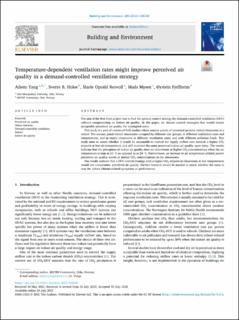| dc.contributor.author | Yang, Aileen | |
| dc.contributor.author | Holøs, Sverre Bjørn | |
| dc.contributor.author | Opsahl Resvoll, Marie | |
| dc.contributor.author | Mysen, Mads | |
| dc.contributor.author | Fjellheim, Øystein | |
| dc.date.accessioned | 2021-08-11T10:03:35Z | |
| dc.date.available | 2021-08-11T10:03:35Z | |
| dc.date.created | 2021-08-10T09:46:00Z | |
| dc.date.issued | 2021 | |
| dc.identifier.issn | 0360-1323 | |
| dc.identifier.uri | https://hdl.handle.net/11250/2767345 | |
| dc.description.abstract | The aim of the Best Vent project was to find the optimal control strategy for demand-controlled ventilation (DCV) without compromising on indoor air quality. In this paper, we discuss control strategies that would ensure acceptable perceived air quality for unadapted users.
This study is a part of a series of field studies where sensory panels of untrained persons visited classrooms at a school. The sensory panel visited classrooms occupied by different user groups, at different ventilation rates and temperatures, and in empty classrooms at different ventilation rates, and with different pollutant loads. This study aims to assess whether it would be reasonable to control the supply airflow rate towards a higher CO2 setpoint at low air temperature, and still maintain the same perceived indoor air quality upon entry. The results indicate that the perception of indoor air quality does not deteriorate at higher CO2 concentrations when the air temperature is kept at 21 °C as opposed to at 24 °C. Furthermore, an increase in air temperature yielded poorer perceived air quality scores at similar CO2 concentrations in the classrooms.
Our results indicate that a DCV-control strategy with a higher CO2 setpoint in classrooms at low temperatures would not compromise perceived air quality. Further research would be needed to assess whether the same is true for indoor climate-related symptoms or performance. | en_US |
| dc.language.iso | eng | en_US |
| dc.publisher | Elsevier | en_US |
| dc.rights | CC BY 4.0 | * |
| dc.rights.uri | http://creativecommons.org/licenses/by/4.0/ | * |
| dc.subject | Perceived air quality | en_US |
| dc.subject | Odour intensity | en_US |
| dc.subject | Demand-controlled ventilation | en_US |
| dc.subject | School | en_US |
| dc.subject | Indoor air quality | en_US |
| dc.title | Temperature-dependent ventilation rates might improve perceived air quality in a demand-controlled ventilation strategy | en_US |
| dc.type | Peer reviewed | en_US |
| dc.type | Journal article | en_US |
| dc.description.version | publishedVersion | en_US |
| dc.rights.holder | © 2021 The Authors. | en_US |
| dc.subject.nsi | VDP::Teknologi: 500 | en_US |
| dc.source.volume | 205 | en_US |
| dc.source.journal | Building and Environment | en_US |
| dc.identifier.doi | 10.1016/j.buildenv.2021.108180 | |
| dc.identifier.cristin | 1924902 | |
| dc.relation.project | Norges forskningsråd: 255375 | en_US |
| dc.source.articlenumber | 108180 | en_US |
| cristin.ispublished | true | |
| cristin.fulltext | original | |
| cristin.qualitycode | 2 | |

